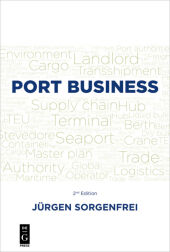 Neuerscheinungen 2018Stand: 2020-02-01 |
Schnellsuche
ISBN/Stichwort/Autor
|
Herderstraße 10
10625 Berlin
Tel.: 030 315 714 16
Fax 030 315 714 14
info@buchspektrum.de |

Port Business
2nd ed. 2018. XX, 540 S. 120 b/w ill., 40 b/w tbl. 230 mm
Verlag/Jahr: DE GRUYTER; DE G PRESS 2018
ISBN: 1-547-41702-1 (1547417021)
Neue ISBN: 978-1-547-41702-5 (9781547417025)
Preis und Lieferzeit: Bitte klicken
Port Business is essential reading for all those with an interest in trade and transportation and the role of ports in the global supply chain. It discusses the various types of ports in existence, identifies the major ports per category, analyzes what the key business drivers are, describes their governance, how they are managed, which trends influence them, and what kind of impact they have on supply chains. Dr. Jürgen Sorgenfrei uses his significant consulting and project development experience within the international ports, shipping, rail & logistics sector, and in global economics, trade, analytics, and forecasting as well as in intermodal hinterland transport to provide this comprehensive overview of port management. The book is a combination of a strong background in principles and practical knowledge and is an indispensable resource for those interested in maritime economics. .
Part 1: Development of Ports 1
Chapter 1: History of Ports: The Ten Aims of a Port 3
1.1 Ancient Egypt 3
1.2 Roman Empire 7
1.3 Constantinople 12
1.4 Venice and the Mediterranean Merchant Trade 15
1.5 Imperial China: Early Ming Dynasty 16
1.6 Hanseatic League 20
1.7 Historical Drivers of Port Development 28
Chapter 2: Driver of Port Business 31
2.1 Economic Drivers 33
2.2 Political Drivers 35
2.3 Logistical Drivers 38
2.4 Technical Drivers 40
2.5 Financial Drivers 44
2.6 The "Port Model" 45
2.7 Impact on "Port Master Planning" Process 49
Chapter 3: Major Commercial Ports 51
3.1 Classification of Ports 51
3.2 Container Ports 56
3.3 General Cargo Ports 61
3.4 Liquid Bulk Ports 65
3.5 Dry Bulk Ports 67
3.6 RoRo Ports 68
3.7 Ferry Ports 72
3.8 Passenger Ports 73
3.9 Cruise Ports 75
Part 2: Ports in Maritime Supply Chain 79
Chapter 4: The Role of Ports in Supply Chains 81
4.1 Definition "Ports" 81
4.2 Port Functions 83
4.3 Port Customer Groups 84
4.4 Port Cluster 86
4.5 "Port" Terms in Common Use 87
Port versus Terminal 87
Container Port 89
General Cargo Port 90
Bulk Port 90
RoRo Port 90
Ferry Port 90
Passenger Port 91
Cruise Port 91
Universal Port 91
Dedicated Port/Terminal 91
Main Port 93
Major Port 93
Minor Port 94
Hub Port + Feeder Port 94
Gateway Port 96
Way Port/Zero-Deviation Port 97
Transhipment Port + Transit Port 97
Regional Port 100
Sea Port 101
Deep Water Port 101
River Port 102
Inland Port 103
Dry Port 103
Free Port 103
State Port/Service Port/Public Port 104
Autonomous Port 104
Tool Port 104
Landlord Port 104
Private Port 105
Industrial Port/Factory Port 105
Home Port (Cruise) 105
Commercial Port/Noncommercial Port 106
Statistical Port 106
Big Port 106
Chapter 5: Trade & Transportation 107
5.1 Macroeconomic Relations 107
5.2 Drivers of Global Trade 116
Political Alliances and Free Trade Agreements 116
Deregulation and Privatization of Public Services 117
Distribution of Natural Resources 118
Globalization of Sourcing and Production 119
Spreading Out of Buyer Markets 120
Environmental Awareness 121
Innovations 122
Integrated Supply Chain Logistics 122
5.3 Antitrade Movements/Protectionism 123
5.4 Transport Value and Affinity 125
5.5 International Commercial Terms 131
Chapter 6: Ports in Transportation Chain 137
6.1 The Role of Ports in Supply Chain 137
6.2 Port Hinterland 143
Loco-Potential 147
6.3 Ports and Shipping Networks 148
Shipping Networks 148
Port Networks 154
6.4 Port Costs in Transportation Chains 161
Chapter 7: Cargoes 165
7.1 Port Cargo Categories 168
Liquid Bulk 171
Dry Bulk 173
General Cargo, Break Bulk, Heavy Lift, Oversized 174
Container 177
RoRo Cargo 179
All Cargoes 180
7.2 Cargo Measurement 183
Linear Measure or Unit of Length: Two-Dimensional 184
Solid Measure or Cubic Measure: Three-Dimensional 185
Weight Measure/Ton Deinitions 185
Billing Systems: Weight + Volume 187
Arabesque: Additional "Ton" Definitions 189
Unit Measure 191
Twenty-Foot Equivalent Unit (TEU) 191
Intermodal Transport Unit (ITU) 193
Flat or Flat Rack 193
RoRo Unit or RoRo Flat 193
Car Equivalent Unit (CEU) 194
Verified Gross Mass (VGM) 195
7.3 Errors in Port Cargo Measurement 195
Workflow Difficulties 196
Ineffective Enforcement 196
Perception that Weight Is Peripheral 196
Using Different Standards to Measure 197
Statistical Consequences 198
Part 3: Port Management 203
Chapter 8: Frame Conditions 205
8.1 Port Business Environment 205
8.2 Basic Management Concepts 208
8.3 Port Labor Organization 217
8.4 Cultural and Religious Influence 220
Chapter 9: Port Commercialization and Privatization 223
9.1 Background for Port Reform 223
9.2 Commercialization 225
9.


